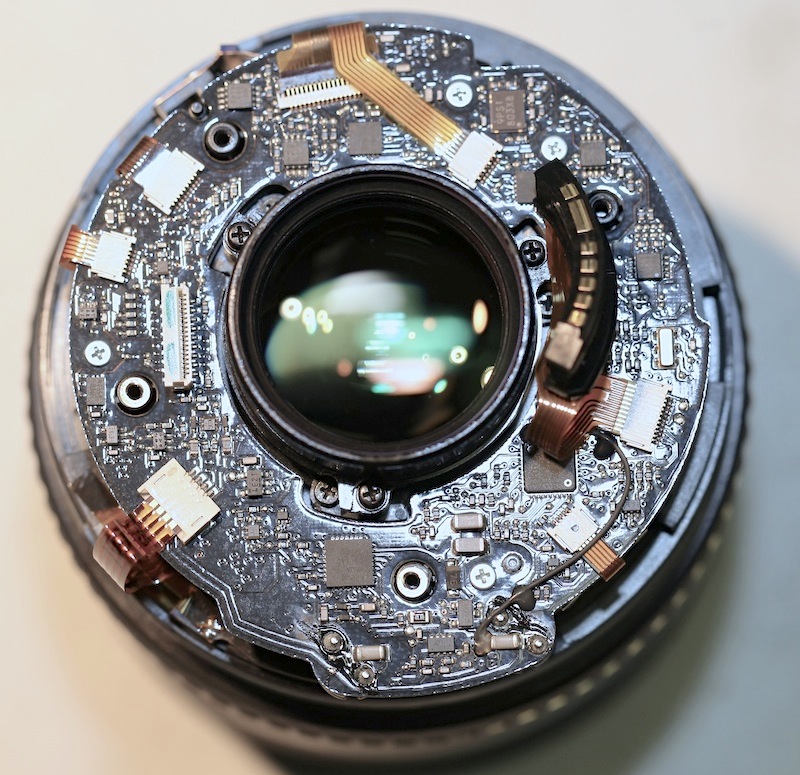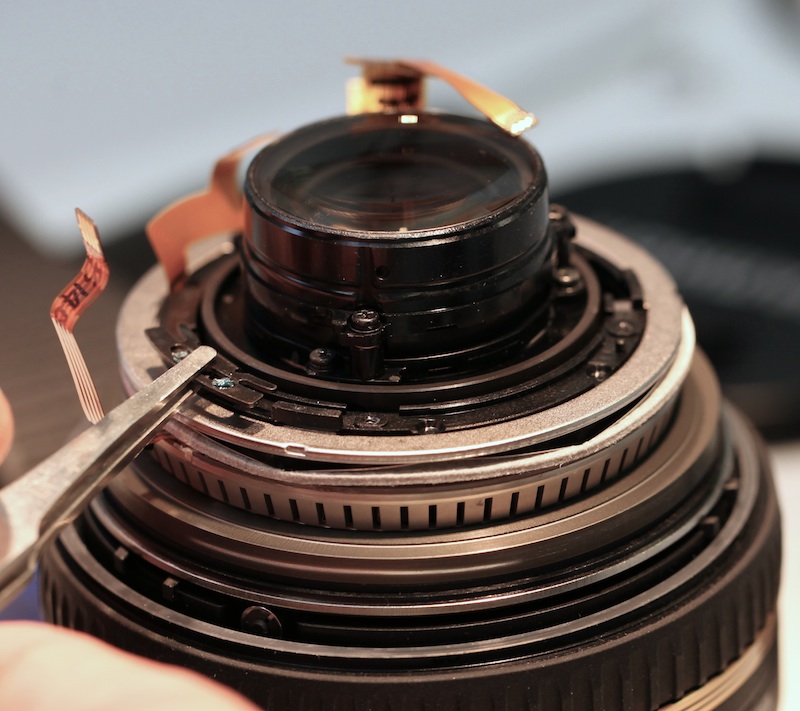Equipment
Lensrentals Repair Data: 2012-2013
Correction: Lenses called “Rokinon” in the “Weeks to Failure” rate incorrectly included Bower & Samyang branded products. Because of this error, data for lenses called “Rokinon” lenses has been removed. We apologize for this inaccuracy, and any confusion that may have resulted therefrom.
What Is This?
We have a unique opportunity: We own a very large number of lenses and cameras subjected to rather harsh conditions. Basically, we have a laboratory set up to stress test photography equipment and we share those results with you.
Our numbers reflect heavy and hard use. Your personal equipment shouldn’t fail nearly as often; it isn’t subjected to rental conditions. But this does provide some comparison about how fragile various pieces of equipment are.
It’s not completely scientific, but with data on over 12,000 copies resulting in over 2,000 repairs it’s a bit more useful than posts on a forum going back and forth between “mine’s great” and “mine sucked.”
This list is not a comment about how good a lens is. It’s simply data about how often it breaks under harsh conditions. Some of my favorite lenses and cameras are rather fragile.
Some Things to be Aware of
First of all this is our largest survey ever. This is a full year’s data (the last report was for 6 months) and we have a lot more lenses and cameras than we used to have, going out on a lot more rentals. A larger sample size helps improve data accuracy, and this sample is more than twice as large as any we’ve done previously.
We present our data as the number of rental weeks per failure. That levels the playing field since nothing (as best we can tell) stops working while sitting on a shelf. For example, if we had 100 copies of a lens, each rented for 30 weeks during the year, and we’ve had 30 repairs, that lens averages 100 rental weeks per failure.
Equipment Age
Our average item is less than a year old, and none are more than two years old. For the vast majority of items the average copy is just under a year old.
But if an item has been released in the last 8 or 9 months, all the copies are new and repairs may seem falsely low. They may also seem falsely high – a problem that was noticed with the first production run may be quietly fixed before subsequent production runs. For example, the battery doors on the first batch of Nikon D800 cameras broke if you looked at them hard, but we’ve not seen that at all since the first 6 months.
When an item is discontinued we still stock it for a while, so all of the copies are nearly two years old and the repair rate may get higher. This year the Canon 24-70 f/2.8 and 5D Mk IIs are good examples of discontinued items where the fleet is older. This may also happen to a lesser extent when demand drops. For example Nikon D600 and D800 demand has dropped compared to last year, so we haven’t added many new copies and the fleet average for those cameras is over a year old.
The Failure Rate Is Higher This Year
How we do this survey is always a work in progress. I made one major change between last year’s survey and this year’s. I call more repairs ‘failures’ and fewer ‘damage’. Damaged items don’t count for this survey, so if a lens is dropped and dented, while it goes to repair we don’t count it as a failure.
But I noticed something while looking at our data. We’ve always considered a broken AF/MF switch, for example, to be damage. That makes sense, part of the lens is broken off. But when I took 31 broken AF/MF switches out of the repair spreadsheet and moved them to the ‘damaged’ side, I noticed that 14 of them were from one lens; the Canon 35mm f/1.4L. That means almost half of the AF/MF switch replacements were done on a lens that accounts for 1% of all of our copies.
I found a lot of similar examples. Lots of lenses get dropped (our customers email and tell us). Most are absolutely fine afterwards. With a few, though, every time a copy gets bumped the zoom key jumps out of its slot, elements shift and the optical resolutions changes, and the barrel breaks in half.
So I decided, by the power vested in me as keeper of the spreadsheets, that it made more sense to consider ‘indirect damage’ to be more about fragile lenses and less about minor drops and bumps. Obviously, front or rear element scratches, sand or water in the lens, dented filter rings and broken hoods are direct damage and don’t count in our numbers. Everything else is now a repair.
New Lenses are Now Repaired, Not Returned
Last year, if a lens had a problem ‘out of the box’ we sent it in for exchange and it didn’t show up on the repair list. This year, we sent it in for repair (there were business reasons for that). This increased the repair rate, too. (When you buy 5,000 or so lenses a year, that 3% out-of-the-box problem rate means another 150 repairs.)
I also counted repeat repairs as separate repairs this year. If a lens went in to repair, came back not fixed, and went back again it counted as two repairs (last year it would have been one). I did this thinking if it was your lens, you would definitely consider it two repairs. I also thought if a company was worse at getting things fixed the first time, our data should reflect it somehow.
Because of these changes, the failure rate was nearly twice as high as last year. Last year’s report cut off ‘high failure rate’ at less than 155 rental weeks per failure. This year it’s 60 rental weeks per failure. It also means you can’t compare a lens’ weeks-until-failure rate from last year to this year and say “it got worse”, because almost every lens got worse. On the other hand, if one got better, it really did get better.
Equipment Failure Rates
Limitations and Disclaimers
This is an annualized repair rate of the period from July 1, 2012 to July 1, 2013. We list the 5% of our inventory that had the highest repair rate (fewest rental weeks per failure).

- Unlike some manufacturers, we consider failure of an internal part without obvious external damage to be a failure, not the result of impact.
We make no comment at all on lenses that we have less than 10 copies of (that’s not enough data to be useful) or that have been in stock less than 3 months — unless something spectacular is going on.
The following lenses or cameras we carry were NOT evaluated because we have less than 10 copies or they were in stock less than 3 months.
- Canon: 180 f/3.5 L; MPE-65 Macro; 800mm f/5.6 IS L; 200-400 f/4 IS L; 400mm DO IS
- Nikon: 14mm f/2.8; 16mm f/2.8; 20mm f/2.8; 200mm f/2.0 VR; all PC-E lenses
- Sony: all Alpha prime lenses; NEX 20mm f/2.8; NEX30mm f/3.5 macro; NEXOSS; 55-210;
- Tamron: 180 f/3.5
- Sigma: 20 f/1.8; 70mm f/2.8 Macro; 105mm macro; 180 f/2.8 OS; 300-80mm
- Panasonic: All cameras except GH2, 45-175mm lens, 100-300 lens
- Olympus m4/3: 9-18mm
- All Leica, Pentax, Fuji, and Schneider items
If we carry the lens and it isn’t listed above or below, then its weeks per failure was greater than 60 weeks.
I used the following descriptions of the sample size: Very large – over 3,000 rental weeks and 200 copies; Large – over 1,000 rental weeks and 90 copies; Moderate – over 400 rental weeks and 40 copies; Small – under 400 rental weeks, 10 to 40 copies. The larger the data sample, the more reliable the results. Small samples sizes are more likely to just be random events.
We’ll look a little further into those by telling you what it was that went wrong. If 4 different things go wrong in 4 different lenses out of 50 in stock, it’s likely to be random. If all 4 have exactly the same problem, it’s more likely there is a weakness in the lens.
The average rental weeks per failure for all lenses and cameras this year was just over 100 . Everything fails eventually, but it usually takes a long time to do it.
Finally, the usual ‘don’t read this and lose your mind‘ caveat applies: These are heavily used, frequently shipped lenses. A lens owned by someone who uses it on weekends, takes good care of it, and doesn’t ship it around the country would have a much lower failure rate.
Lenses with High Failure Rates
First, let’s give you an idea of how well things last in general. I screened over 350 lenses for failure rates. The distribution by rental weeks per failure is shown in the table below (It’s not a bell curve because I lumped all the long-term survivors into the category > 140 weeks). Overall I find it pretty impressive how well lenses hold up under harsh conditions.
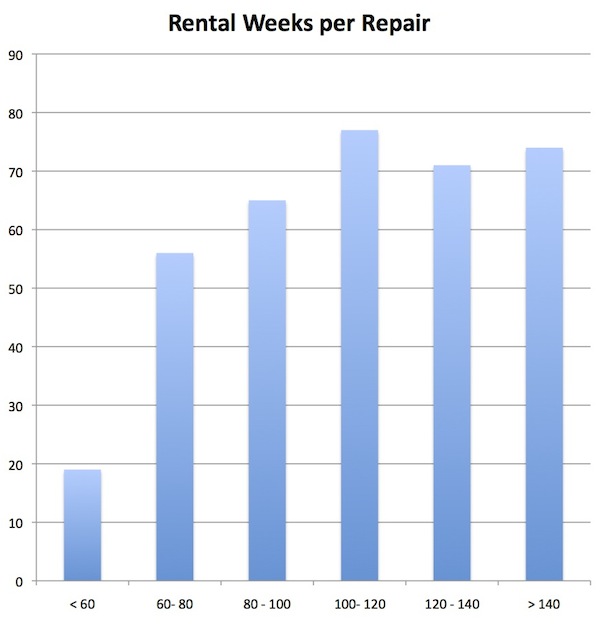
The 19 photography lenses with repair rates more frequent than every 60 weeks are listed below.
Lens Weeks to Failure Sample Size Common Problems
Tamron 17-50 f/2.8 VC 37 Small Optics (4), Focus jam (3), Zoom jam (2), VR
Sony 18-200 OSS LE 37 Small Zoom jam (4), electronics (3)
Nikon 70-200 f/2.8 VR II 39 Large Zoom jam (16), Optics (15), tripod footplate (8)
Nikon 14-24 f/2.8 40 Large Zoom jam (17), Optics (3), Aperture (2)
Sigma 70-200 f/2.8 OS 40
Small Motor (3), OS unit (2), Optics (2)
Sigma 50-500 OS 41 Moderate Motor (3), OS unit (3), zoom (3), optics (3)
Canon 14mm f/2.8 II 41 Large Optics (11), focus assembly (2)
Tamron 24-70 f/2.8 VC 42 Moderate focus jam (4), Optics (2), VC (2)
Canon 70-200 f/2.8 IS II 42 Very Large Optics (29), IS (7) , loose barrel (7), zoom jam (6)
Sigma 120-300 OS 45 Small AF Motor (3), OS system (2)
Canon 70-200 f/4 IS 51 Moderate Optics (5), electrical (2)
Sony 70-200 f/2.8 51 Small AF motor (4)
Canon 24-70 f/2.8 58 Very Large Optics (21), Zoom jam (3), focus jam (2)
Tokina 11-16 f/2.8 II 58 Moderate AF/MF Clutch (6), loose barrel (5), AF motor (2), Diaphragm (1)
To give you some perspective, I’ve included a table of video items we carry, because generally video gear is more fragile than photo gear (and probably gets abused more). The first two items are two of our highest repair video items, the CP.2 lenses are our most durable item, the rest just a couple of random picks I was interested in.
Item Weeks to Failure Sample Size Common problems
Cooke Panchro Cine Lens 6 Small Focus cams break (6)
Sony FS 7U camcorder 26 Moderate Broken viewfinder (4), Broken handle (3), Loose LCD (3)
Manfrotto 504 HD fluid head 47 Moderate Leg locks (6), pan spring (4)
Black Magic Camcorder 60 Moderate Broken SSD reader assembly (5)
Zeiss CP.2 lenses 140+ Large Optics (2). focus (2)
Cameras
You may have noticed no cameras made the list this year, which is a good thing. The highest repair rate camera was the Nikon D800 (65 weeks to repair), mostly because of autofocus problems. Nothing else was less than 80 weeks to repair. I should mention that part of the reason is I didn’t include some common problems as repairs: the D700‘s peeling grips, D600’s dust issues, and buttons popping off of the OM-D I didn’t consider failure since most people will take care of them at home. Even if I did include those things, though, those cameras would still not have made the list.
However, some common problems we saw a year ago like the 5D Mk III having bent CF pins and the D800 battery doors snapping off seem to have been fixed and have ceased to be an issue at all. Camera bodies, both SLR and mirrorless, had the lowest repair rates we’ve seen in 5 years.
Removed From the List
Off the list this year are the Canon 35mm f/1.4 and 100-400 IS; Nikon 105 f/2.8 VR Micro and 16-35m f/4 VR; and Tokina 16-26 f/2.8. For completeness I’ll mention that the Canon and Nikons above were barely off, all of them in the 60-70 weeks to repair range. The Tokina did seem to be better this year, with nearly 90 weeks per repair.
A Few Observations
Several other lenses on the list have small sample sizes, so there is more concern that they may just be a random event – just a few less repairs and they wouldn’t be here. I think that may be true for the Tamron 17-50 f/2.8 VC – it hasn’t been here before and there seem to be several different problems going on. The Sony 18-200 OSS LE is a new lens that has already had one recall. Since many of it’s problems were electronic I suspect it’s something that will be fixed before next year’s report.
The other small sample-size lenses are here every year, for the same problems, so I do think they really are fragile lenses.
Other conclusions I think are valid:
- Every manufacturer has some great lenses and some weak lenses.
- 70-200 f/2.8 lenses are likely to fail no matter who makes them. We think of them as ‘built like tanks’ because they have that heavy, all-metal case. That case, though, is as packed with mechanics and electronics as anything you’ve ever seen. There’s a LOT of stuff in there that has to work perfectly. Inevitably, some of that stuff breaks.
- Sigma’s big zooms still have trouble with their HSM motors and OS units, but Sigma really does seem to be doing better. Their large zoom lenses are still on the list but the frequency is lower than it used to be, in a year when my new accounting system made most numbers look worse. Sigma’s prime lenses and smaller zooms have excellent repair rates.

- The insides of 70-200 lenses are densely packed with working parts.
The Most Reliable Lenses
I get asked every year to name the most reliable lenses, but I decline. There are two reasons. First, the repair curve is rather one-tailed – we have outliers that get repaired a lot, but because we sell everything at two years of age, there is a huge glop of lenses with low repair rates. I can give you a simple generalization, though: If you want to buy a lens that will last decades, then you want a completely mechanical prime lens.
It’s just logic. Electronic components get hot, or moist, and eventually capacitors leak or solders break.
Zoom mechanisms move a lot and eventually the components supporting the zooming elements wear out. (Focus elements move too, but not as much and generally with a lot smaller mass.

All focusing motors will fail eventually. They are electronic and they move.
An IS unit is electronic, has a motor, and moves hundreds of times a second.
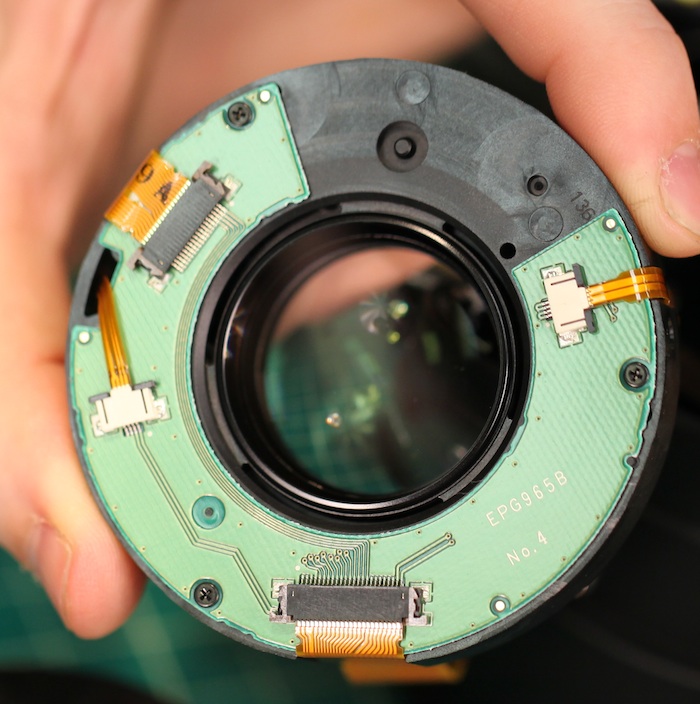
All of that being said, do I want an autofocus lens that zooms and has a stabilized image? Yes, I do. But the simple reality is the more complex a lens is, the more likely it is going to be to fail someday. It is no coincidence that the lenses that last 120+ weeks at Lensrentals are generally primes without image stabilization, and the ones that frequent the most repaired list are usually zooms with image stabilization.
I’ll pause a second here for those of you who don’t believe in the laws of physics to say, “Well, my IS zoom has lasted 10 years without a problem.” That’s cool; statistics suggest many IS autofocus zooms will last 10 years if you’re careful with them.
But if we look at large numbers the failure rate will be higher for zooms than primes, for lenses with IS than lenses without it, and even for autofocus lenses than for manual focus lenses. I’m not certain about mechanical versus electronic apertures – we see similar numbers of failures in both.
Factory Service Center Report
I care about this a more than most of you, probably, since I send things in for repair every single day while many of you have never sent anything in for repair. But someday you will need a repair, trust me on that.
Remember that service varies greatly geographically. We are U.S. only; service is very different in Europe, Asia, even Canada. The data below is only pertinent to you if you live in the U. S.
In general, factory service got better in late 2012 and 2013. I suspect widespread consumer complaining, particularly about Nikon USA, accounts for some of that. I know that some companies began looking at service as an opportunity to enhance their own reputation. Tamron announce with their ‘3 day guarantee repair’ turnaround time and Sigma an enhanced ‘commitment to quality assurance’ program. Nikon started to sell some consumer replaceable parts on their website.
Turnaround Time
Repair turnaround time had a few changes compared to last year. Olympus had some disarray this year. (In case you weren’t aware, Olympus suddenly closed their repair center and for several weeks no one knew where anything was, or even where you could send a repair.) Their average turnaround time is higher because several items were gone for several months during the chaos, but even if I took those away they still would be the slowest by a good margin.
Sony made a huge improvement compared to last year, dropping from around 30 days on average to 12. Nikon actually is improving more than it appears at first glance. Repair turnaround time has decreased from nearly 30 days in late 2012, to around 20 days now. Most of the other Factory Service Centers stayed about the same.
I didn’t list Leica because they don’t really have a U. S. repair center; most things have to go to Germany. Their turnaround time is leisurely at nearly 35 days, but this includes shipping, reshipping, customs clearance, etc.
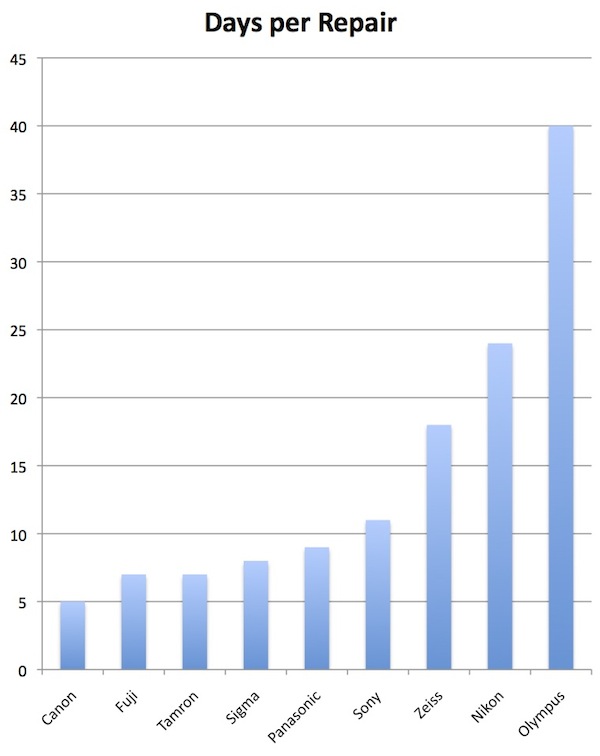
Repair Costs
Repair costs went up just a bit this year, but not anything like the sudden jump we saw in early 2012.
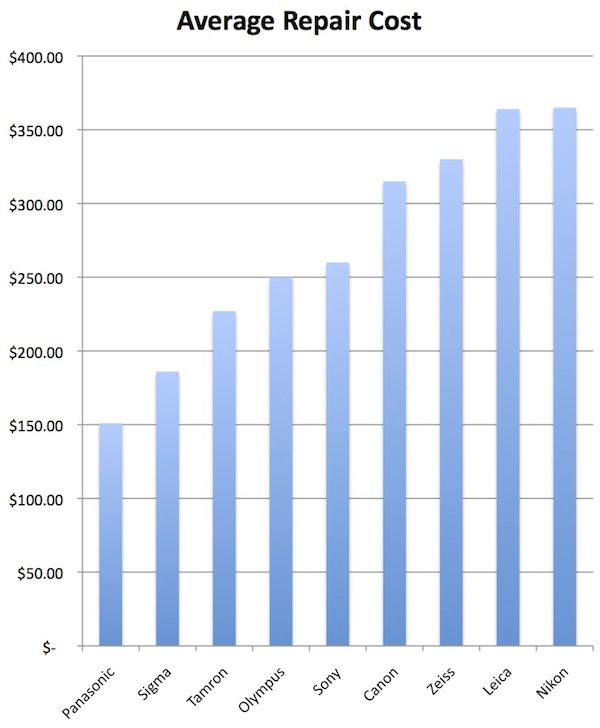
Tokina is absent from the table because we stopped sending anything in to them years ago. If we can’t fix it ourselves, we use an independent service center. They may be much better now, but I have no information either way.
Before you start dancing a jig about your brand’s low repair costs or complaining about its high costs, remember that repairs are generally a flat, tiered rate based on the item’s sale price. That means for a $500 lens, a basic repair is probably $80-$100, while for a $2,000 lens the basic repair is likely $200-$225. When you consider mirrorless gear generally costs a lot less than SLR gear and third-party lenses cost less than brand-name lenses, it should be obvious some of the price difference in this graph is just from that.
Obviously, the 4 companies with the highest repair prices are repairing the most expensive equipment. From a purely ‘price of equipment’ standpoint, Panasonic, Sigma, Tamron, and Olympus are about the same, while Sony fits in between the two groups (which is expected given it’s mixture of equipment).
One thing I’ve started seeing that I really don’t like: some companies (Sony particularly) have started charging a nonrefundable repair estimate fee. If you send your lens in with a scratched element and decide after seeing the $600 replacement cost that you’ll just live with it, it can cost you $135 to get your lens back. This is something you want to check before you send an item in for repair (unless you know it’s so totally broken you’d throw it away if it can’t be fixed).
One reason I really don’t like this is simple: even a non-working lens or camera is worth something sold for parts (check eBay – some things go for more than half the new price when sold as ‘not working, for parts only’). If anything, the company should be paying you for keeping your ‘not repairable’ item. I guarantee you they aren’t throwing it away.
The other reason I don’t like it is it’s cheating. If you call and ask the replacement costs for a 16-350mm Bazooma front element, they usually tell you we have to look at before we can give you a quote, even though it’s a flat-rate fee. So basically they’re saying, “it will cost you $135 for us to tell you how much the charge is.” I can understand needing to see the lens before deciding the fee for more complex things, of course.
I will point out that this year I didn’t even consider sensor replacements in figuring repair costs because we’ve simply stopped replacing scratched and damaged sensors. At $1,000 to $1,800 for a full-frame sensor replacement, it doesn’t make economic sense anymore; we either convert the cameras to infrared or part them out. I mention this because I’ve always said, “learn how to clean your own sensor.” I’m getting hesitant to say that to someone who’s never done it before. Scratching a sensor during cleaning is rare, but nowadays it’s a devastating expense if it does happen.
Battery & Chargers
I didn’t include this in the main part of the article, because honestly I think it might be us — simply because I haven’t heard much about it in any online forums. When I looked at replacement parts we’ve purchased this year one thing really jumped out at me: battery chargers.
We have several hundred battery chargers, obviously. When they break, we buy a replacement charger. For chargers in general, we replace about 2% per year. With two exceptions. All smaller Nikon chargers (MH-18a, MH-22, MH-24, MH-25, MH-26, and Mh-27) are replaced at a rate of 14% to 16% per year. All Fuji chargers (BC45W, BC50, BC65N) are replaced at a rate of 17% to 21% per year. No other charger is over 2%.
Since I haven’t seen anyone complaining about this online, I have to consider it’s something we do. My first thought is that we ‘top off’ batteries constantly. A battery comes back from rental with 2/3 of a charge, but we fully charge it before sending it out. This isn’t what most people do at home. So it may be those chargers get stressed somehow by our topping them off day-in and day-out. The other brand’s chargers might have some circuitry that isn’t bothered by that.
But any of you have other suggestions, please let me know and help me figure this one out.
ADDENDUM!! Looking at the list and saying “Canon has the highest repair rate because they have the most lenses on the list” is pretty silly. We carry far more Canon lenses than any other brand. So they would be expected to have far more lenses in the ‘high repair’ list. The fact that they don’t dominate the list actually indicates they have a lower repair rate (they do, slightly, but it’s certainly not significantly lower).
Looking at things statistically (as best as can be done) there really isn’t a significant difference either by all lenses, or by fraction of lenses with higher repair rates between any of the brands. There are some slight overall differences in repair rate by brand but none that seem statistically significant, or even close to it.
I repeat, every brand has some fragile lenses. If you must Fanboy go ahead. But don’t start your comment with “Roger Said” ’cause Roger didn’t.
Roger Cicala
Lensrentals.com
August, 2013
Author: Roger Cicala
I’m Roger and I am the founder of Lensrentals.com. Hailed as one of the optic nerds here, I enjoy shooting collimated light through 30X microscope objectives in my spare time. When I do take real pictures I like using something different: a Medium format, or Pentax K1, or a Sony RX1R.
-
Jasmine
-
Jeffrey D
-
SwampYankee
-
Chris
-
Tony Bologna
-
Mike
-
Andreas
-
Kay O. Sweaver
-
Robert Panick
-
Tomas
-
Kenan
-
Eddie Wrei
-
Siming
-
Joe
-
Daniel G.
-
Siming
-
Ian Anderson
-
Jeremy
-
Jay Frew
-
Kai
